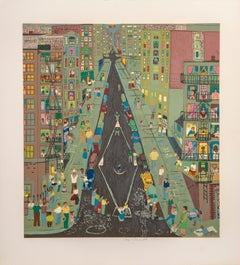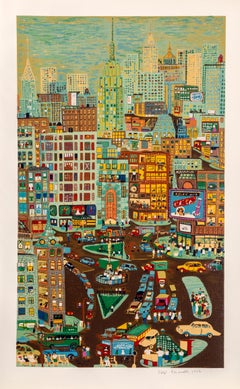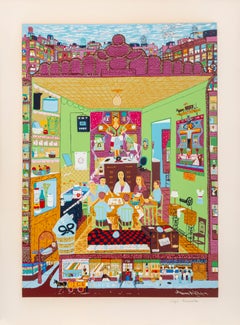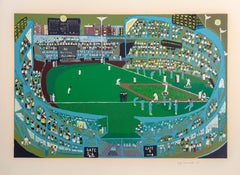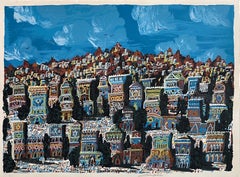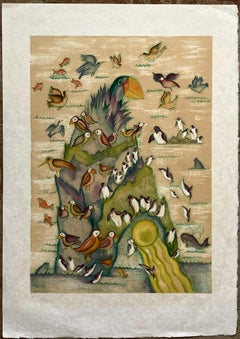Ralph Fasanella Art
to
10
2
8
7
3
3
7
Overall Height
to
Overall Width
to
1
9
4
3
2
2
1
1
1
1
1
1
1
1
1
1
1
1
10
1
1
7
1
10
6,961
3,323
2,514
1,213
8
2
1
1
1
Artist: Ralph Fasanella
Bridges, New York - Screenprint by Ralph Fasanella
By Ralph Fasanella
Located in Long Island City, NY
Artist: Ralph Fasanella, American (1914 - 1997)
Title: Bridges
Year: 1974
Medium: Screenprint on Arches Paper, signed and numbered in pencil
Edition: 250, AP 25
Image: 25 x 34 inches...
Category
1970s Folk Art Ralph Fasanella Art
Materials
Screen
Stickball, New York Screenprint by Ralph Fasanella
By Ralph Fasanella
Located in Long Island City, NY
Rendered in hues of blue, teal, and brown, this Ralph Fasanella print is a bustling depiction of New York City including views of identifiable landmarks from various boroughs and loc...
Category
1970s Folk Art Ralph Fasanella Art
Materials
Screen
Empire State Building, Screenprint by Ralph Fasanella
By Ralph Fasanella
Located in Long Island City, NY
Artist: Ralph Fasanella, American (1914 - 1997)
Title: Empire State
Year: 1974
Medium: Screenprint on Arches Paper, signed and numbered in pencil
Edition: 300
Image: 40 x 24 inches
S...
Category
1970s Folk Art Ralph Fasanella Art
Materials
Screen
Family Supper, Serigraph by Ralph Fasanella
By Ralph Fasanella
Located in Long Island City, NY
Artist: Ralph Fasanella, American (1914 - 1997)
Title: Family Supper
Year: 1974
Medium: Screenprint on Arches Paper, signed in pencil
Edition: 250, AP 25
Size: 41 in. x 31 in. (104.1...
Category
1970s Folk Art Ralph Fasanella Art
Materials
Screen
Ballpark, Silkscreen by Ralph Fasanella
By Ralph Fasanella
Located in Long Island City, NY
Artist: Ralph Fasanella, American (1914 - 1997)
Title: Ball Park
Year: 1974
Medium: Screenprint on Arches Paper, signed and numbered in pencil
Edition: 250
Image: 25 x 37 inches
Size...
Category
1970s Folk Art Ralph Fasanella Art
Materials
Screen
Going to Work, New York Screenprint by Ralph Fasanella
By Ralph Fasanella
Located in Long Island City, NY
Rendered in hues of blue, teal, and brown, this Ralph Fasanella print is a bustling depiction of New York City including views of identifiable landmarks from various boroughs and loc...
Category
1980s Folk Art Ralph Fasanella Art
Materials
Screen
Outsider Folk Art American Mid-Century Naive WW2 Self Taught WPA Depression Era
By Ralph Fasanella
Located in New York, NY
Outsider Folk Art American Mid-Century Naive WW2 Self Taught WPA Depression Era "Victory for Now"
Ralph Fasanella (1914-_1997) "Victory and After,” gouache on paper. Signed, titled...
Category
1940s Outsider Art Ralph Fasanella Art
Materials
Gouache, Paper
May Day, Screenprint by Ralph Fasanella
By Ralph Fasanella
Located in Long Island City, NY
Artist: Ralph Fasanella, American (1914 - 1997)
Title: May Day
Year: 1974
Medium: Serigraph, signed and numbered in pencil
Edition: 250
Size: 31 in. x 43 in. (78.74 cm x 109.22 cm)
Category
1970s American Modern Ralph Fasanella Art
Materials
Screen
Feast of San Gennaro, New York Screenprint by Ralph Fasanella
By Ralph Fasanella
Located in Long Island City, NY
The Feast of San Gennaro was a traditional celebration in Naples for Saint Gennaro, who became a martyr in the year 305. Long celebrated in Italy, immigran...
Category
1970s Folk Art Ralph Fasanella Art
Materials
Screen
Sand Lot Baseball
By Ralph Fasanella
Located in Saratoga Springs, NY
Signed lower right and dated 1954.
Bio:
FASANELLA, RALPH (1914-97) was a self-taught painter who created large, colorful and intricate paintings of working-class culture and American politics from 1945 until his death in 1997.
Fasanella had an artistic vision born of a working life. A child of Italian immigrants, he spent his youth delivering ice with his father and enduring the harsh regimen of a Catholic reform school. During the Great Depression, Fasanella worked in garment factories and as a truck driver.
From his mother—a literate, sensitive, and progressive woman, Fasanella acquired a social conscience. Through her influence he became active in antifascist and trade union causes. Fasanella's political beliefs were radicalized by the Depression. His antifascist zeal led him to volunteer for duty in the International Brigades fighting fascism in Spain, where he served in 1937-1938.
Upon his return to New York City Fasanella became an organizer for various unions, particularly the United Electrical, Radio, and Machine Workers of America, with whom he achieved some major organizing successes.
In 1945, disillusioned by the labor movement and plagued by a painful sensation in his fingers, Fasanella started to draw. He left organizing and began to paint full time. He painted obsessively, capturing the vibrant moods of the city and the tumult of American politics. For a brief time he received some critical notice for his work, and had shows of his work in galleries as well as union halls. Fasanella included in his paintings a profusion of brightly colored details, showed interiors and exteriors simultaneously, and combined past and future. He populated his paintings with likenesses of family and friends.
In 1950 Fasanella married Eva Lazorek, a schoolteacher who supported the couple through over two decades of artistic obscurity and blacklisting by the FBI. In the 1950s Fasanella retreated from political content in his works out of fear of reprisals. With the emergence of the New Left in the 1960s, however, his works became large, sharply focused political essays using images from the popular media. In 1972 Fasanella was featured in "New York" magazine and in an illustrated coffee-table book, "Fasanella's City". His large-scale, intricate paintings of urban life and American politics were then introduced to art critics and the public.
In the late 1970s Fasanella spent two years in Lawrence, researching the 1912 Bread and...
Category
1950s Other Art Style Ralph Fasanella Art
Materials
Canvas, Oil
Related Items
Israeli Naive Art Screen Print Lithograph Jerusalem, Sanhedrin Old City Folk Art
By Gabriel Cohen
Located in Surfside, FL
Bold color lithograph, hand signed in pencil and numbered AP IX/X (artist’s proof 9/10), Jerusalem Print Workshop blind stamp lower right. On French Arches paper.
Gabriel Cohen, Self taught, Naive painter was born in Paris in 1933, to parents from Jerusalem with a father who studied the kabbalah. Throughout World War II, the family hid from the Nazis in Paris. Images of Nazi soldiers appear in several of his paintings. In 1949, when Gabriel was 16, the family returned to Israel. They managed to save enough money to move back to the quarter where both parents were born: Ohel Moshe in Nachlaot. Gabriel served in the artillery corps and after the army, went back to live in his parents' house and earned a living polishing diamonds. The head of the polishing plant, who noticed his employee's artistic skill, allowed him to paint during work hours. He once asked Cohen if he could draw a tiger. Cohen drew him a tiger. And he did a lot of sculpting and painting on glass. He also loved to play the guitar, especially flamenco style.
Critics say he is one of Israel's greatest naive-style painters. Along with Shalom of Safed, Kopel Gurwin and Natan Heber, He is renowned as one of Israel's greatest living naive-style folk art painters, recipient of the Jerusalem Prize for Art (1987), a permanent entry in encyclopedias of naive painting, who exhibited his work not only in Israel, but also in Paris, Venezuela, Denmark and Germany; the same Gabriel Cohen whose colorful , bold paintings were exhibited at the Jewish Museum in New York in 1987 alongside works by Marc Chagall; the same Gabriel Cohen about whom curator and art scholar Gideon Ofrat says, "There is no questioning his greatness."
He has shown in Paris on the Rue de Rosiers in the Marais. His impressions of his journeys, mostly imaginary, yet some real, are expressed in Cohen's paintings. Huge, colorful canvases rich in precise detail and fantasy, in which he paints the Eiffel Tower and the Russian steppes or the vistas of Paris and the Tower of Babel
"In my opinion, it's also because the Tower of Babel has some kind of phallic, erotic meaning, but also because of the internationalism, of the mixture and confusion of nations, which is an essential element in Gabi Cohen's work," says Gideon Ofrat.
There is no superlative that has not been lavished on Cohen's work by art critics, since he began showing his paintings at age 40, All the art critics seemed to agree at once that Cohen is one of the greatest naive-style painters in Israel. Their counterparts abroad seconded this view.
About a year and a half ago, Zadka organized a show for Cohen at the Jerusalem Artists' House. The Tel Aviv Museum bought a painting of Gabi's and so did the Israel Museum, and several artists bought his drawings. He is a great, great painter. There is no painter who is more of a symbolist and illustrative artist than he is. As a painter myself, I admire him." The Yom Kippur War in 1973 sparked an artistic breakthrough for Cohen; it was at that time that he began to sit on the sidewalk after his work as a diamond polisher and paint. Not long afterward, in early 1974, he did a painting he called "Moses on the Mountain." Ruth Debel, of the Debel Gallery in Ein Kerem, passed by and saw it on the street. She asked how much he wanted for it, and for the first time in his life, he realized that his work had financial value.
His first show was at the Debel Gallery in 1974. The response was overwhelming. Cohen was immediately declared a genius. His paintings at the gallery were purchased and he continued to create new paintings. That same year, he was invited to take part in a group exhibition of naive artists at the Kunsthaus in Zurich, and a year later, his work was included in a traveling show of naive-style artists from Israel that was exhibited in Denmark and Germany. Soon after that he was invited to be part of group shows in Venezuela and at the Tel Aviv Museum.
Cohen had four solo shows at the Debel Gallery.
Awards And Prizes
1987 Jerusalem Prize for Painting and Sculpture
1999 Shoshana Ish-Shalom Prize for special contribution to art, Jerusalem
He has exhibited alngside all of the Israeli great artists. including
Naive Art Group exhibition Gvanim Art Gallery, Jerusalem
Rubin, Rachel Roman, Yitzhak Zarembo, Leah Moscovitz, Shalom (of Safed) Steinberg, Michael Danisov, Salva Harbon, Haim Cohen, Gabriel Chanannia, Joseph (Jojo)
Local Hero...
Category
20th Century Folk Art Ralph Fasanella Art
Materials
Screen, Lithograph
Island Paradise
By Francoise Deberdt
Located in San Francisco, CA
Artist: Francoise Deberdt – French (1934- )
Title: Unknown
Year: circa 1980
Medium: Color Etching
Sight size: 23 x 16.25 inches.
Sheet size: 30 x 21 inches On thick Japon paper
Sig...
Category
1980s Folk Art Ralph Fasanella Art
Materials
Color, Paper, Etching
Naive Lithograph Paris Train Station Wedding Party, Honeymoon Scene Folk Art
Located in Surfside, FL
Hand signed, limited edition on BFK Rives French art paper. I believe the title is Honeymoon.
Jan Balet (20 July 1913 in Bremen – 31 January 2009 in Estavayer le Lac, Switzerland), was a German/US-American painter, graphic artist and illustrator. Affected by the folk art style of naive art he worked particularly as a graphic artist and as an Illustrator of children's books. His works exhibit a dry wit and refreshingly candid, whimsical, satirical view of life.
His uncle was the famous painter and illustrator Benno Eggert. Many well-known personalities of the time were friends of his grandfather, i.e. the painters Hans Purrmann, Karl Caspar, Maria Caspar-Filser (cousin of his mother), the writer Martin Andersen Nexo, the Swabian poet Wilhelm Schussen as well as the poet and writer Oskar Wöhrle.
In 1929, at the age of 17, he moved to Berlin at the invitation of his father and studied Drawing at the college of Arts and Crafts (Kunstgewerbeschule Ost am Schlesischen Bahnhof). A year later, he went to live with his mother and his grandmother, in Munich. Balet transferred his studies to the Munich College of Arts but was dismissed in 1932. He went on to study with Professor Ege, at a private school for commercial art. During this time he also worked at an institute for lithography and for the art gallery Wallach. Balet rented his first small studio at the age of nineteen, where he manufactured and sold hand colored Bavarian woodcuts. 1934 he passed the entrance examination to the Akademie der Bildenden Künste München and undertook further studies with Olaf Gulbransson. His work is of a popular style similar to Michel Delacroix, Charles Fazzino and James Rizzi. In early 1938 Balet was recruited by the German military and because his ancestor's passport was not complete, he was forbidden to associate further with the Akademie der Bildenden Künste München. Later that year Balet emigrated to the USA, settled in New York and painted rustic furniture for a living. One winter he jobbed as a skiing teacher in Vermont and occasionally jobbed as an advertising commercial artist. Among other projects, he painted the cafeteria of the largest of New York's department stores R.H. Macy. From time to time Balet's designs appeared in the fashion magazine Mademoiselle and in 1943 he became Art Director at the magazine. Balet became so successful as a commercial artist that he was able to give up paid employment and start his own business. He worked for the radio station CBS, magazines such as Vogue, House and Garden, House Beautiful, The Saturday Evening Post, Glamour, Good Housekeeping, This week. After the war ended in 1945 he acquired U.S. citizenship. Balet commuted between his studio in New York and an old, boat house in the dunes of Montauk, Long Island, which he had converted to a studio where he painted and drew. His first children's book Amos and the Moon was published in 1948. Despite what was regarded in the USA as fashionable art Abstract, Op-art and Pop Art, Balet continued to paint in his own naif style.
Art work (Children books and sketchbooks)
1948 Amos and the moon, Henry Z. Walck Verlag New York
1949 Ned, Ed and the lion
1951 What makes an orchestra
1959 The five Rollatinis, J. B. Lippincott Co. Verlag New York
1965 Joanjo, Pharos Verlag Basel
1966 Das Geschenk Eine portugiesische Weihnachtsgeschichte, Betz-Verlag München
1967 Der König und der Besenbinder, Betz-Verlag München
1969 Der Zaun, Otto Maier Verlag München
1969 Ladismaus, Betz-Verlag München
1979 Ein Skizzenbuch, Windecker Winkelpresse
1980 Katzen-Skizzen, Windecker Winkelpresse
1981 Skizzen-Paare, Windecker Winkelpresse
1981 Die Leihkatze oder Wie man Katzen lieben lernt, Windecker Winkelpresse (Author: Otto Schönberger)
1982 Paris-Skizzen, Windecker Winkelpresse
1984 Hellas-Skizzen, Windecker Winkelpresse
1993 Wasser-Skizzen, Edition Toni Pongratz
1994 Die Zeppeline des Jan Balet, Zeppelin-Museum Friedrichshafen (Taschenbuch)
2008 Angekommen: Gedichte (Author: Hans Skupy)
Publicationen, which Jan Balet illustrated
1945 Alarcon, P.A.: Tales from the Spanish, Allentown
1948 Hanle-Zack, D.: The golden ladle, Chicago-New York
1952 Wing, H.: Rosalinda, Chicago
1953 Wing, H.: The lazy lion...
Category
20th Century Folk Art Ralph Fasanella Art
Materials
Lithograph
Julian Schnabel, Portraits, Nemo Librizzi
By Julian Schnabel
Located in New York, NY
NEMO LIBRIZZI
Year: 1998
Medium: 25-color silkscreen with poured resin
Size: 38 x 36 inches (97 x 91 cm)
Edition: 90
Price: $4900
Suite of 3 Also avail...
Category
1990s Contemporary Ralph Fasanella Art
Materials
Screen
Woman with Cat
By Linda Le Kinff
Located in San Francisco, CA
This artwork "Woman with Cat" c.1990 is an original color serigraph by noted French artist Linda Le Kinff, born 1949. It is hand signed and numbered 12...
Category
Late 20th Century Contemporary Ralph Fasanella Art
Materials
Screen
Miss Prather's Class
By Winfred Rembert
Located in New York, NY
Color Reduction woodcut from 4 blocks with 4 silk screen colors and embossing on white Rives BFK paper
Edition 28/30, Unframed
MassArt welcomed artist Winfred Rembert for the 2014 Master Print Series, an artist in residency project during which, an established artist transforms an idea into physical artwork, and invites students to collaborate in the art-making process.
A self-taught artist, Winfred Rembert records a painful chapter of American history in autobiographical paintings, created on hand-tooled and dyed leather, which explore the lives of African Americans in Jim Crow-era Georgia. After taking part in civil rights demonstrations, he survived a lynching only to be sent to prison to do hard labor on a chain gang. Another inmate taught him leatherworking and Rembert began depicting his past in engaging compositions and vibrant color. In many scenes, Rembert offers a raw view of racism, inequality, and violence while celebrating his community’s resilience in the face of such overwhelming injustice.
Winfred Rembert also participated in the Adderley Lecture series, which features distinguished artists, historians, and writers and was established in 1995 in memory of Tyrone Maurice Adderley. Past Adderley lecturers have included Chakaia Booker, Melvin Edwards...
Category
2010s Folk Art Ralph Fasanella Art
Materials
Woodcut, Screen
CATALINA
By Thomas McKnight
Located in Aventura, FL
Serigraph on paper. Hand signed and numbered by the artist. Image size 26.5 x 30.25 inches. Custom framed as pictured. Frame size approx 37.5 x 41.5 inches. From the roman numer...
Category
1980s Contemporary Ralph Fasanella Art
Materials
Screen, Paper
CONCORD
By Thomas McKnight
Located in Aventura, FL
Hand signed and numbered by the artist. Image size 16 x 18 in. Frame size approx 25 x 28 in. Artwork is in excellent condition. Certificate of Authenticity included. Edition of CC. ...
Category
1990s Contemporary Ralph Fasanella Art
Materials
Screen, Paper
II Cup of Joe
Located in San Francisco, CA
This artwork titled "II Cup of Joe" c.1990, is an original color serigraph by American artist Rickey Jewell Hohimer, 1946-2021. It is hand signed, titled and numbered 250/300 in pencil by the artist. The image size is 19.5 x 23.5 inches, framed size is 26.75 x 30 inches. The artwork is in excellent condition, the frame is slightly damaged at the top, and will be replaced by a new similar black frame when sold. This will bring the over all condition to excellent.
About the artist:
Although formally trained with a MFA in painting, Rickey Jewell Hohimer has used the styles of Van Gogh and Gaughin to reach for the spontaneity and simplicity of today's folk art. Hohimer creates figures which are not photos of reality; they are romantically stylized to encourage straightforward emotional responses both to the colorful images and to the situations in which they find themselves. Each of Hohimer's paintings lays out a basic story line to which viewers add their own details. "I want the viewer to become personally involved. My paintings offer a change from those which encourage extensive intellectualizing about what the artist is trying to convey. I want viewers to smile -- to enjoy the whimsical nature of what they are experiencing -- to feel it, not to analyze it!. His jazz paintings are stories on canvas of inspired musicians spontaneously making music of the moment. Life in the jazz age is clubs and nightlife beckoning to musicians to produce jazz art...
Category
Late 20th Century American Modern Ralph Fasanella Art
Materials
Screen
Julian Schnabel, Portraits, Xavier Mascaro
By Julian Schnabel
Located in New York, NY
XAVIER MASCARO
Year: 1998
Medium: 25-color silkscreen with poured resin
Size: 38 x 36 inches (97 x 91 cm)
Edition: 90
Price: $4900
Suite of 3 Also ava...
Category
1990s Contemporary Ralph Fasanella Art
Materials
Screen
Two Lovers
By Linda Le Kinff
Located in San Francisco, CA
This artwork "Two Lovers" c.1990 is an original color serigraph by noted French artist Linda Le Kinff, born 1949. It is hand signed and numbered 40/300 in ...
Category
Late 20th Century Contemporary Ralph Fasanella Art
Materials
Screen
Angel of Hope and Strenght - Screenprint Handsigned
By Shepard Fairey
Located in Paris, FR
Shepard Fairey (Obey Giant)
Angel of Hope and Strenght
Screenprint
Handsigned in pencil by the artist
Dated 2020
Numbered /550
Size 61 x 46 cm (c. 24 x 18 in)
Excellent condition
Category
2010s American Modern Ralph Fasanella Art
Materials
Screen
Ralph Fasanella art for sale on 1stDibs.
Find a wide variety of authentic Ralph Fasanella art available for sale on 1stDibs. If you’re browsing the collection of art to introduce a pop of color in a neutral corner of your living room or bedroom, you can find work that includes elements of blue and other colors. You can also browse by medium to find art by Ralph Fasanella in screen print, paint, canvas and more. Much of the original work by this artist or collective was created during the 20th century and is mostly associated with the modern style. Not every interior allows for large Ralph Fasanella art, so small editions measuring 28 inches across are available. Customers who are interested in this artist might also find the work of Victor Delfin, Günther Kieser, and Igor Galanin. Ralph Fasanella art prices can differ depending upon medium, time period and other attributes. On 1stDibs, the price for these items starts at $1,200 and tops out at $75,000, while the average work can sell for $1,500.

